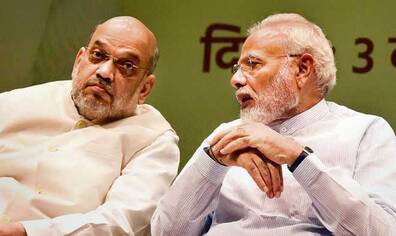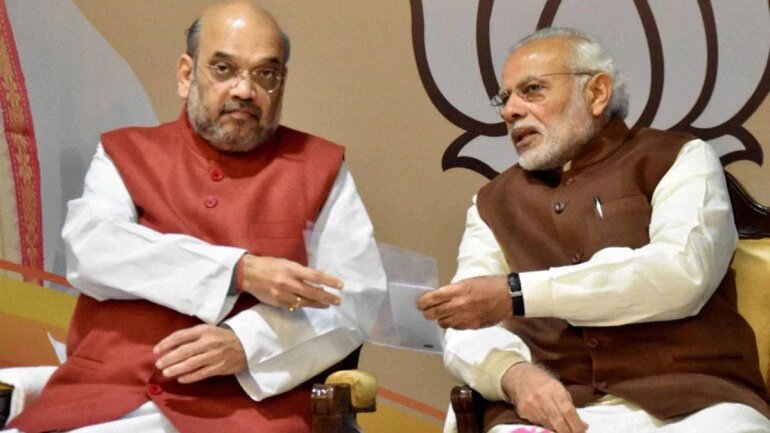Source – tribuneindia.com
The BJP is engaged in a two-pronged ideological project that seeks to assert Hindu hegemony as much as it works to make one leader the unquestioned authority over much of India. At the national level, the BJP, led by Narendra Modi, prevailed quite magnificently in the General Election earlier this year. But as we are yet to have that much-promoted ‘one nation, one poll’, the states continue to throw up challenges for the BJP.
First, there is the problem of plenty and the consequence of initiating growth at the expense of traditional allies. That is what really lies at the heart of the Shiv Sena breaking free of the BJP and attempting another arrangement with the NCP and Congress. The current Modi-Shah-led BJP has a very different approach to coalitions and allies than the Vajpayee-led arrangement that ruled from 1998 to 2004. In its current avatar, the BJP diminishes the regional parties and takes over their space. Once the senior partner in the Maharashtra arrangement, the Sena has had to live with diminishing clout and the fear of losing its USP. A consequence of the Sena departure from the NDA is that a section of the BJP now believes it should have fought on every seat in Maharashtra and given no space to the regional party to play its games. Soon after the Maharashtra verdict, the BJP played hardball with its ally in Jharkhand, the All-Jharkhand Students’ Union (AJSU) and refused to agree to its seat demands for state elections that will take place in five phases starting on November 30. The AJSU is now contesting on its own.
The question now is whether this psychological approach will extend to Bihar, where the BJP is in government with Nitish Kumar’s JD(U) and where elections take place exactly a year from now.First, let us recall that the current state government is technically forged against the mandate that was given to the grand alliance of Nitish and Lalu Prasad Yadav’s RJD in 2015. It was that pairing that had given rise to the idea of a mahagathbandhan that has currently been discredited. Although Home Minister Amit Shah has stated that the Bihar elections will be fought under the leadership of Nitish Kumar, the BJP has actually been covertly working in the state with certain elements of the RJD to clip Nitish’s wings. There is a push-pull happening in Bihar and given what’s happened in Maharashtra, the BJP would want to safeguard its investment and back a weakened Nitish who could subsequently be dumped. In another strange twist in the world of NDA allies, the JD(U) has announced it will be fighting every seat in Jharkhand on its own even as the party continues to refuse to join the Modi government at the Centre.
Secondly, the BJP would also need to rework its recent approach to “social engineering”, a term put into usage by one-time RSS ideologue KN Govindacharya, who had worked as organisation secretary of the BJP at a critical time in the party’s growth. After the 2014 win of Narendra Modi, the BJP went against conventional caste and community parameters in choosing leadership for the states.
In the two states that have most recently voted, Haryana and Maharashtra, and where the BJP’s performance was underwhelming, the party had rather courageously gone against the dominant caste syndrome. This essentially means that they selected chief ministers that did not come from social groups that have traditionally wielded power in these states. It was all supposed to be going smoothly and had the BJP won, the party would have been credited with reinventing the wheel.
But as it turned out, the dominant castes struck back in both states. In Haryana, the BJP’s social coalition was essentially an anti-Jat rainbow, but the party failed to win a majority. To form the government, it had to turn to a 31-year-old Jat leader, Dushyant Chautala, from a political dynasty and make him the Deputy Chief Minister of the state. In Haryana, the strong re-emergence of the Congress too was largely due to the Jat leadership of a former Chief Minister.
Similarly, in Maharashtra, now under President’s rule, the old political warhorse, NCP leader Sharad Pawar, made much of his campaign about injured Maratha pride — the traditional ruling community of the state that had been restive through much of the reign of Brahmin Chief Minister Devendra Fadnavis.
In Jharkhand, too, the BJP had gone against the convention of having an Adivasi Chief Minister in a state that was supposedly created for the tribals that make up 27 per cent of the population. The state formed on November 15, 2000, had had only Adivasi chief ministers till December 27, 2014, when Raghubar Das from a backward caste became Chief Minister. Still, the dominant caste syndrome would not apply here in the same manner as it did in Haryana and Maharashtra as Jats and Marathas have economic and muscle power, unlike the tribals.
Given the BJP’s disappointing performance in the last round of Assembly polls, the party will be waiting to see if the JMM-Congress-RJD alliance that is projecting tribal leader Hemant Soren as the CM, would make a breakthrough. If it does, then the case for arithmetical alliances by the opposition will get strengthened again. Soren has described the BJP as a “sinking ship”, but is it so? Internal surveys convince the BJP that going it alone could be the best option (CSDS data for the 2019 Lok Sabha polls shows that the BJP got 64 per cent of the Hindu vote in Jharkhand).
Third, there is now the question of the BJP’s ability to absorb defectors from other parties, a situation that is playing out most visibly in Karnataka, where the BJP got a government after orchestrating absenteeism from 17 members of the preceding Congress-JD (S) coalition. The SC, in a controversial order, has now allowed these legislators to contest elections, but they had originally fought against BJP candidates, so that is creating local-level problems. Besides, the Karnataka defectors and the BJP would be worried by the results of polls in Maharashtra, Haryana and some byelections where party-hoppers were mostly defeated.
For all its apparent might, therefore, the BJP does have vulnerabilities in the states. On the one hand, the Modi persona and an enhanced Hindu identity appear to be the gifts that keep giving results. Yet, state contests show local divergences and sudden islands of spirited fightbacks that do not always go according to the script that is planned, promoted and executed with might and money.

